
All right, since I talk about photographing small subjects pretty frequently, I figured it was about time to introduce you to some of the tricks. You’ll find that most of these, with some variations, are practiced by anyone serious about macro photography, and if you have any desire to start doing this, you should know what it is you’re getting into and why some of these techniques are used.
Above is my typical macro rig, which can be handheld or put onto a tripod. The key feature of this is the Bogen/Manfrotto 330B Macro Bracket, seen here in grey supporting two strobe units on either side of the camera. The primary reason for this is that subjects at extreme magnifications are often very close to the lens, so a standard hot-shoe mounted strobe is aimed way too high to illuminate a subject only centimeters in front of the lens, and may even be blocked by the edge of the lens itself.
The second use for this is to provide lighting that is not direct into the subject, which often looks unrealistic and doesn’t show detail, especially textures, very well. A little indirect lighting can appear much more natural, show shapes and textures, and even give some definition from the background with a shadow. The second strobe unit provides a little fill-flash, as it’s called, which basically means some light to soften shadows that get too harsh. Roughly half of the time I shoot without a second strobe, but there are times when it’s needed for good results.
 The strobes are necessary to counteract an inescapable trait of macro photography. At high magnifications (and this applies to telephoto work as well,) depth-of-field drops down very low. Depth-of-field is the range of acceptably sharp focus that extends in front of, and behind, the point you focused on. This means that if you focus on the eyes (and you’d better!) the hind end of the body may be out of focus, unless you take some steps. The main one is, use a smaller aperture like f16, which increases depth-of-field. But like everything in photography, there’s a tradeoff, and in this case it means you just reduced the amount of light coming in to the film or digital sensor. To counteract that, you can leave the shutter open longer, not recommended because you’ll either shake the camera or have your subject move during exposure, or you have to produce a lot more light – hence the strobes. The bright light that they put out, however, can cause harsh shadows and let the background, if it’s significantly behind your subject, fall into darkness. In this tight crop, note that the eyestalks of this snail are sharp, but the shell is already well out of focus – note also the shadows that give shape and depth to the snail and the tree.
The strobes are necessary to counteract an inescapable trait of macro photography. At high magnifications (and this applies to telephoto work as well,) depth-of-field drops down very low. Depth-of-field is the range of acceptably sharp focus that extends in front of, and behind, the point you focused on. This means that if you focus on the eyes (and you’d better!) the hind end of the body may be out of focus, unless you take some steps. The main one is, use a smaller aperture like f16, which increases depth-of-field. But like everything in photography, there’s a tradeoff, and in this case it means you just reduced the amount of light coming in to the film or digital sensor. To counteract that, you can leave the shutter open longer, not recommended because you’ll either shake the camera or have your subject move during exposure, or you have to produce a lot more light – hence the strobes. The bright light that they put out, however, can cause harsh shadows and let the background, if it’s significantly behind your subject, fall into darkness. In this tight crop, note that the eyestalks of this snail are sharp, but the shell is already well out of focus – note also the shadows that give shape and depth to the snail and the tree.
The macro bracket allows you to position the strobes where you need them, and mine is modified with the addition of two tripod-size screws on the arms, both shown holding my strobes. This gave me some more flexibility in placing and angling the strobes, and was a simple modification. The strobe to the right (larger one) is my main unit, and is connected to the camera by a cord which allows full communication for balanced, accurate lighting. I highly recommend having one of these cords, though Canon needs to increase the sturdiness of this ridiculously expensive cord. Mine has been repaired (see the grey base under the strobe) due to the failure of its cheap plastic construction. On the other side is a basic slave strobe, so called because it can be fired off by sensing the light from the main unit, so it can flash simultaneously without needing any connection at all. For illustrative purposes in the top photo, however, I have it connected via a PC plug that I added to Canon’s off-camera cord, at the top of the camera. This tends to be more dependable – the slave function can miss sometimes depending on ambient light.

Here’s another view of the bracket, showing some of the versatility. Both side arms can be adjusted in angle, including simply moving them out of the way, and the camera mount itself has an additional arm that allows you to switch to vertical orientation without moving the strobes – alternately, you can angle the strobes vertically while shooting a horizontal layout, whatever your subject demands. Bogen/Manfrotto is not the only company that makes these, but I liked theirs because of the size it can collapse into. When your camera bag is bursting with accessories, the smaller, the better.
Some photographers like either a ring flash or a dual-macro strobe unit, both of which mount directly on the end of the lens and shine their light directly onto the subject. The ring flash is just what it says, a light tube shaped in a ring around the end of the lens, while the dual strobe has two smaller strobe heads on either side of the lens. I dislike both – the ring flash can make strange unnatural-looking highlights on your subject (the sun is not a ring,) while both options provide direct light that doesn’t always show the best detail. Both are also very expensive, mostly because the target buyer is the serious photographer who supposedly will be happy to spend the money for what is essentially a strobe unit with 1/4 the power of a standard unit yet three times the cost. I’m a cheap bastard and don’t fall for ploys ;-)
Another benefit of a second strobe on its own arm is that it can be used to illuminate the background beyond the subject. Exposure is relative. When using a small aperture as I mentioned above, and thus needing a lot of light from your main strobe, this means that the ambient light is less in relation to the strobe, sometimes a lot less. So what happens is your background drops into shadow, or even total darkness. Sometimes this is fine, but the effect it produces is to seem like you’re shooting at night, and takes away any usefulness from having an appropriate background. So the second strobe is aimed beyond your subject to account for this.
No macro work is complete without a good lens that can focus on close subjects. Nearly all camera and lens manufacturers make dedicated macro (or “micro” for Nikon) lenses, and these are often the sharpest lenses you can find and typically allow for a wide aperture to focus on difficult subjects. You will virtually never shoot at these wide apertures, because of the depth-of-field issue above, but when you get close to something interesting and focus is crucial, you often need the light. But there are two other ways to get close focus capability as well. One is with diopters, which are “filters” that mount to the front of an existing lens and change its focus. These are inexpensive, but typically produce less than exciting results, most especially with edge distortion. They work in a pinch and can be a cheap way to get started, but if you’re serious enough to use a bracket, you need to consider something else.
 The second way is with extension tubes, which are much simpler than their price seems to indicate – they’re simply empty tubes that extend the lens further away from the camera. You can see the tube here between the camera and the lens, flanked by silver edges. They work exactly like moving a projector further back from the wall – the image gets bigger. It also gets darker, because the lens is optimized for a certain distance from the film/sensor plane and moving it further back diffuses it more. Extension tubes are only as good as the lens mounted to them, and here’s where I made a pleasing discovery. When my dedicated macro lens started performing sporadically and needed repair, I tried a general purpose lens, my Sigma 24-135 zoom, on an extension tube, and it performed better than any expectations. This will not always be the case, and sometimes you won’t get sharp results with tubes, but they’re also typically 1/4 the cost of a dedicated macro lens. You will lose the ability to focus at distances, but this isn’t much of an issue since they snap on and off in seconds. There is no reason to spring for expensive ones – the inexpensive set of three Kenko tubes I’ve been using for the past decade still appear like new and perform without issue. However, I will say that dedicated macro lenses are the best performers and worth the money, though you don’t always have to get the OEM models to get great results.
The second way is with extension tubes, which are much simpler than their price seems to indicate – they’re simply empty tubes that extend the lens further away from the camera. You can see the tube here between the camera and the lens, flanked by silver edges. They work exactly like moving a projector further back from the wall – the image gets bigger. It also gets darker, because the lens is optimized for a certain distance from the film/sensor plane and moving it further back diffuses it more. Extension tubes are only as good as the lens mounted to them, and here’s where I made a pleasing discovery. When my dedicated macro lens started performing sporadically and needed repair, I tried a general purpose lens, my Sigma 24-135 zoom, on an extension tube, and it performed better than any expectations. This will not always be the case, and sometimes you won’t get sharp results with tubes, but they’re also typically 1/4 the cost of a dedicated macro lens. You will lose the ability to focus at distances, but this isn’t much of an issue since they snap on and off in seconds. There is no reason to spring for expensive ones – the inexpensive set of three Kenko tubes I’ve been using for the past decade still appear like new and perform without issue. However, I will say that dedicated macro lenses are the best performers and worth the money, though you don’t always have to get the OEM models to get great results.
 And finally, one other little contraption that I made myself. This is a softbox strobe extension that positions the light directly over my macro subject, but diffuses the light to appear less like the spotlight effect that the strobe produces by itself. It allows softer, ambient-appearing light to be right over a subject only centimeters in front of the lens, and really is a reflective tube, a reflecting plate at an angle within the drum (a pudding container,) and a piece of plastic grocery bag as the diffuser. You can tell me how well it works by seeing both photos here and the second photo here. All were taken late at night with no ambient light (I focused by flashlight.) Notice the softness of the shadows that gives the appearance of full daylight. There are plenty of flash diffusers available for purchase, but none that I’ve found would move the light to above the subject like this one does.
And finally, one other little contraption that I made myself. This is a softbox strobe extension that positions the light directly over my macro subject, but diffuses the light to appear less like the spotlight effect that the strobe produces by itself. It allows softer, ambient-appearing light to be right over a subject only centimeters in front of the lens, and really is a reflective tube, a reflecting plate at an angle within the drum (a pudding container,) and a piece of plastic grocery bag as the diffuser. You can tell me how well it works by seeing both photos here and the second photo here. All were taken late at night with no ambient light (I focused by flashlight.) Notice the softness of the shadows that gives the appearance of full daylight. There are plenty of flash diffusers available for purchase, but none that I’ve found would move the light to above the subject like this one does.
So is all of this necessary? Well, it depends on your subject, but being limited in what you can do will limit the images you produce. Having the strobe’s light cut off by the edge of the lens will trash the photo entirely, and attempting to juggle a strobe held in your hand, while trying to focus on a tiny subject, is more headache than it’s worth (I know, I’ve tried – I’m trying to save you some of the frustrations I’ve had with all this.) Inadequate light or too-harsh shadows also don’t work very well. If you want to tackle little subjects, sooner or later you’ll end up using a variation of what I’ve described here. Hopefully I can save you a little trial-and-error.
Now, for an example of someone whose work puts mine to shame, check out Igor Siwanowicz’ work at Blepharopsis. He’s gotten past the background darkness issue in most cases, and you can see one of his working rigs on that page. He’s got a big softbox on the strobe to the left of the photo (mounted on, you may note, a Bogen/Manfrotto 330B) and another strobe with diffuser to the right, mounted on its own stand – both appear to be illuminating the beetles. It’s possible that there are more lights covering the background, not seen in the frame. It’s not a portable rig, but it also produces stunning results – such effort can mean the difference between fantastic art and, well, my work. Again, there’s nothing that says you have to do any of this, but if you’re wondering how to achieve certain results, now you have some idea.

 Sometimes, empty space is really empty, and doesn’t seem to say anything. But it does, if only, “There’s nothing around for miles.” The isolation implied by the blank water is as much a photo element as the main subject here, and provides contrast to the sharp, intense detail of the tree stump. The empty space counterbalances the stump in the photo, and the frame is actually split in half diagonally, with almost nothing but grey and white to the upper right, and all of the color and shade in the lower left. This lack of color, by the way, allows us to notice the tiny little green leaves atop the stump, where otherwise we probably could not have.
Sometimes, empty space is really empty, and doesn’t seem to say anything. But it does, if only, “There’s nothing around for miles.” The isolation implied by the blank water is as much a photo element as the main subject here, and provides contrast to the sharp, intense detail of the tree stump. The empty space counterbalances the stump in the photo, and the frame is actually split in half diagonally, with almost nothing but grey and white to the upper right, and all of the color and shade in the lower left. This lack of color, by the way, allows us to notice the tiny little green leaves atop the stump, where otherwise we probably could not have. 





















































 The strobes are necessary to counteract an inescapable trait of macro photography. At high magnifications (and this applies to telephoto work as well,) depth-of-field drops down very low. Depth-of-field is the range of acceptably sharp focus that extends in front of, and behind, the point you focused on. This means that if you focus on the eyes (and you’d better!) the hind end of the body may be out of focus, unless you take some steps. The main one is, use a smaller aperture like f16, which increases depth-of-field. But like everything in photography, there’s a tradeoff, and in this case it means you just reduced the amount of light coming in to the film or digital sensor. To counteract that, you can leave the shutter open longer, not recommended because you’ll either shake the camera or have your subject move during exposure, or you have to produce a lot more light – hence the strobes. The bright light that they put out, however, can cause harsh shadows and let the background, if it’s significantly behind your subject, fall into darkness. In this tight crop, note that the eyestalks of this snail are sharp, but the shell is already well out of focus – note also the shadows that give shape and depth to the snail and the tree.
The strobes are necessary to counteract an inescapable trait of macro photography. At high magnifications (and this applies to telephoto work as well,) depth-of-field drops down very low. Depth-of-field is the range of acceptably sharp focus that extends in front of, and behind, the point you focused on. This means that if you focus on the eyes (and you’d better!) the hind end of the body may be out of focus, unless you take some steps. The main one is, use a smaller aperture like f16, which increases depth-of-field. But like everything in photography, there’s a tradeoff, and in this case it means you just reduced the amount of light coming in to the film or digital sensor. To counteract that, you can leave the shutter open longer, not recommended because you’ll either shake the camera or have your subject move during exposure, or you have to produce a lot more light – hence the strobes. The bright light that they put out, however, can cause harsh shadows and let the background, if it’s significantly behind your subject, fall into darkness. In this tight crop, note that the eyestalks of this snail are sharp, but the shell is already well out of focus – note also the shadows that give shape and depth to the snail and the tree.
 The second way is with extension tubes, which are much simpler than their price seems to indicate – they’re simply empty tubes that extend the lens further away from the camera. You can see the tube here between the camera and the lens, flanked by silver edges. They work exactly like moving a projector further back from the wall – the image gets bigger. It also gets darker, because the lens is optimized for a certain distance from the film/sensor plane and moving it further back diffuses it more. Extension tubes are only as good as the lens mounted to them, and here’s where I made a pleasing discovery. When my dedicated macro lens started performing sporadically and needed repair, I tried a general purpose lens, my Sigma 24-135 zoom, on an extension tube, and it performed better than any expectations. This will not always be the case, and sometimes you won’t get sharp results with tubes, but they’re also typically 1/4 the cost of a dedicated macro lens. You will lose the ability to focus at distances, but this isn’t much of an issue since they snap on and off in seconds. There is no reason to spring for expensive ones – the inexpensive set of three Kenko tubes I’ve been using for the past decade still appear like new and perform without issue. However, I will say that dedicated macro lenses are the best performers and worth the money, though you don’t always have to get the OEM models to get great results.
The second way is with extension tubes, which are much simpler than their price seems to indicate – they’re simply empty tubes that extend the lens further away from the camera. You can see the tube here between the camera and the lens, flanked by silver edges. They work exactly like moving a projector further back from the wall – the image gets bigger. It also gets darker, because the lens is optimized for a certain distance from the film/sensor plane and moving it further back diffuses it more. Extension tubes are only as good as the lens mounted to them, and here’s where I made a pleasing discovery. When my dedicated macro lens started performing sporadically and needed repair, I tried a general purpose lens, my Sigma 24-135 zoom, on an extension tube, and it performed better than any expectations. This will not always be the case, and sometimes you won’t get sharp results with tubes, but they’re also typically 1/4 the cost of a dedicated macro lens. You will lose the ability to focus at distances, but this isn’t much of an issue since they snap on and off in seconds. There is no reason to spring for expensive ones – the inexpensive set of three Kenko tubes I’ve been using for the past decade still appear like new and perform without issue. However, I will say that dedicated macro lenses are the best performers and worth the money, though you don’t always have to get the OEM models to get great results. And finally, one other little contraption that I made myself. This is a softbox strobe extension that positions the light directly over my macro subject, but diffuses the light to appear less like the spotlight effect that the strobe produces by itself. It allows softer, ambient-appearing light to be right over a subject only centimeters in front of the lens, and really is a reflective tube, a reflecting plate at an angle within the drum (a pudding container,) and a piece of plastic grocery bag as the diffuser. You can tell me how well it works by seeing both photos
And finally, one other little contraption that I made myself. This is a softbox strobe extension that positions the light directly over my macro subject, but diffuses the light to appear less like the spotlight effect that the strobe produces by itself. It allows softer, ambient-appearing light to be right over a subject only centimeters in front of the lens, and really is a reflective tube, a reflecting plate at an angle within the drum (a pudding container,) and a piece of plastic grocery bag as the diffuser. You can tell me how well it works by seeing both photos 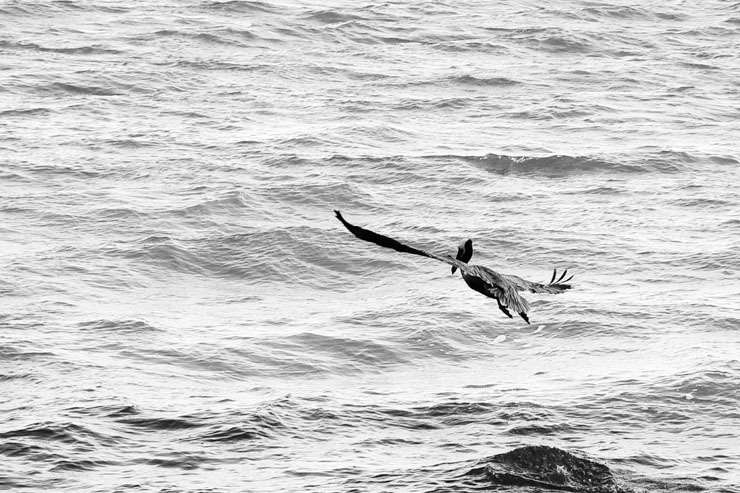
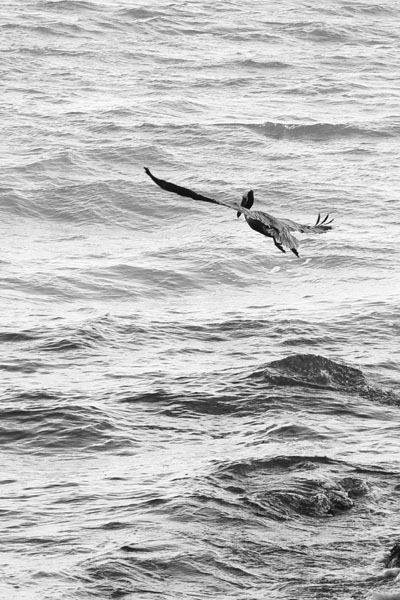 And now we see a different crop. More of the waves below the pelican become visible, and these have an even rougher feel, and slightly confusing. Now we know we’re not dealing with a rock underneath, but the distinct shapes almost seem recognizable, and the viewer may take a moment to frown at them before deciding they really are just waves frozen in time. But in this crop, they have become an element of the scene, almost a subject in themselves.
And now we see a different crop. More of the waves below the pelican become visible, and these have an even rougher feel, and slightly confusing. Now we know we’re not dealing with a rock underneath, but the distinct shapes almost seem recognizable, and the viewer may take a moment to frown at them before deciding they really are just waves frozen in time. But in this crop, they have become an element of the scene, almost a subject in themselves.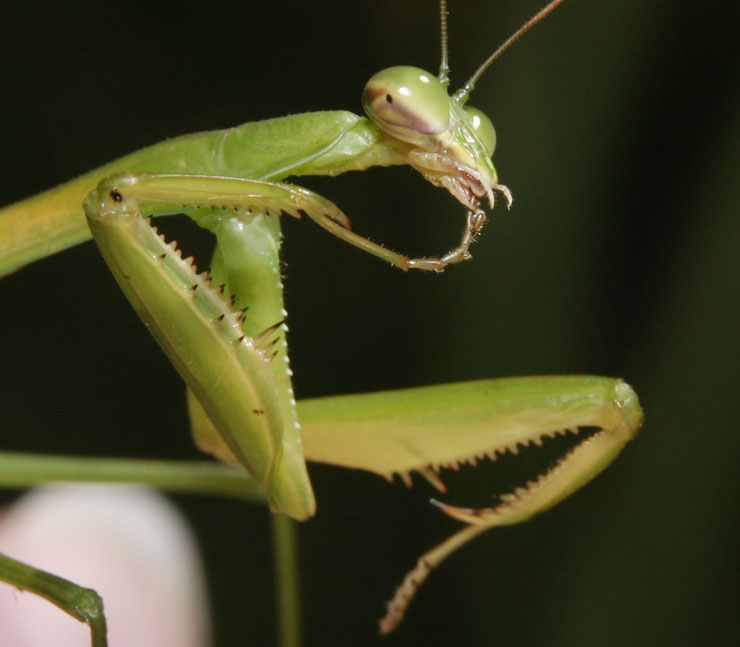

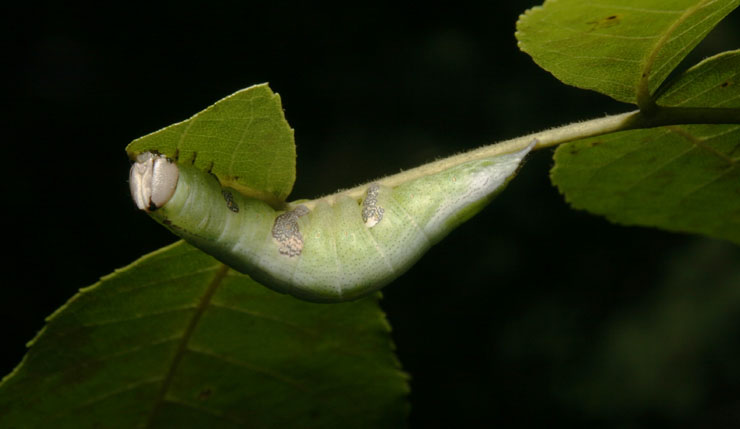
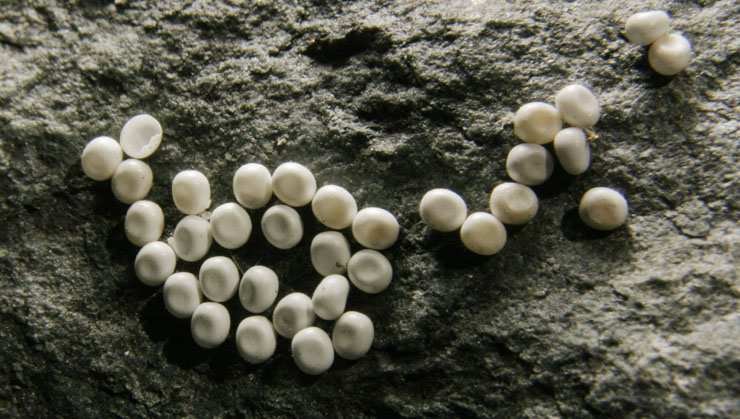
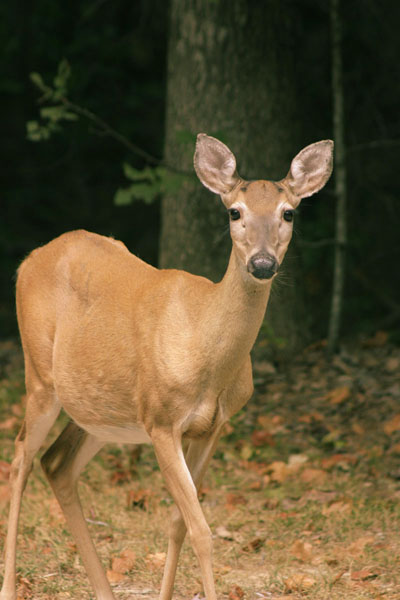 Living on the edge of the woods is a good thing. For some reason, a small herd of White-tailed Deer (Odocoileus virginianus) has taken to visiting roughly around 2:30 PM some days, and when the temperature is cool enough that I can leave the window open, I can hear them foraging. This one was a little surprised to see someone appear in the doorway so close by, but I wasn’t moving enough to spook her off, and she provided several nice portrait poses.
Living on the edge of the woods is a good thing. For some reason, a small herd of White-tailed Deer (Odocoileus virginianus) has taken to visiting roughly around 2:30 PM some days, and when the temperature is cool enough that I can leave the window open, I can hear them foraging. This one was a little surprised to see someone appear in the doorway so close by, but I wasn’t moving enough to spook her off, and she provided several nice portrait poses.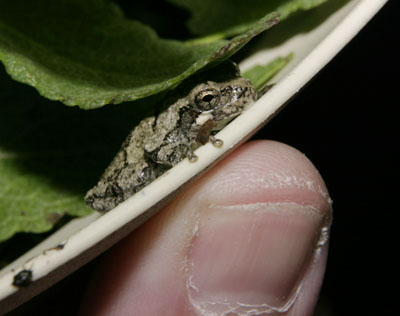 Treefrogs have distinctive toes, ending in a broad and moist pad that lets them cling to vertical surfaces effortlessly. In fact, it can be a little startling to see them jump against a wall and remain there instead of bouncing off. This trait lets them forage for food high in the tree canopies without needing claws, and also lets them scale rocks, leaves, and yes, even people that attempt to grab them. You can get an idea of the size of this specimen by my ugly thumb, included in this shot for scale. I normally see them much larger than this.
Treefrogs have distinctive toes, ending in a broad and moist pad that lets them cling to vertical surfaces effortlessly. In fact, it can be a little startling to see them jump against a wall and remain there instead of bouncing off. This trait lets them forage for food high in the tree canopies without needing claws, and also lets them scale rocks, leaves, and yes, even people that attempt to grab them. You can get an idea of the size of this specimen by my ugly thumb, included in this shot for scale. I normally see them much larger than this.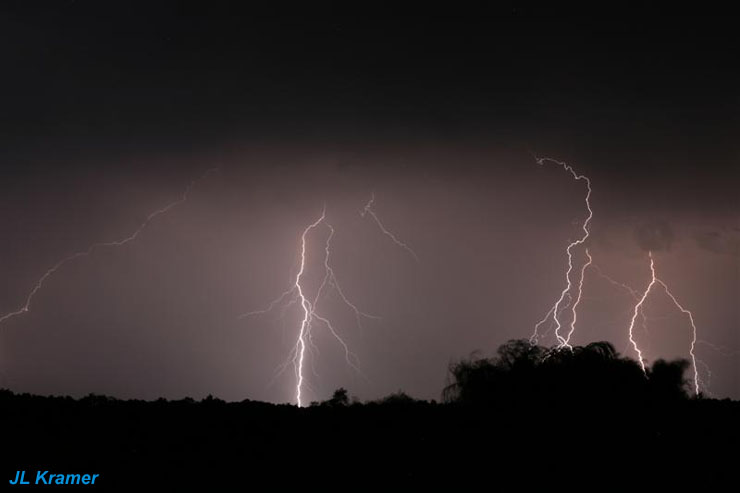
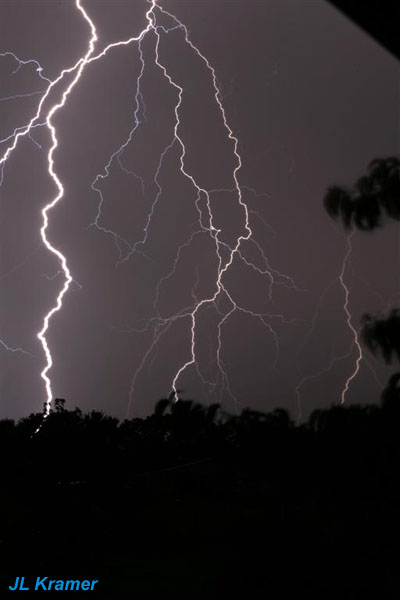 Yes, the midwestern states present some prime opportunities to get lightning photographs, due to their weather patterns and the relative flatness of the land, allowing for good views of approaching and receding storms. I expect, before too long, I’ll get to see (and mutter with jealousy over) some shots he’s gotten among some really sharp scenery or foreground interest. Lightning shots are great, but like everything, they work best if they’re situated among something else in the image that draws attention, creates a mood, or provides contrast. Many times, in order to achieve this, you need to provide some help – the storm itself will keep the skies too dark to provide any illumination of a foreground, so unless your complementary subject works well in silhouette, you need to provide some other light, or get your timing really bang on to catch the fading twilight at sunset to light up your frame, but not too much – remember, lightning usually takes long exposures while you wait for unpredictable bolts. An ideal balance is catching light immediately before sunset, peering in under the level of the storm clouds to throw some light on the ground, while the sky in your frame is darkened by the clouds themselves. Tricky, in many cases, since most storms in the US come from the west where your sunset would be. Such goes the planning of nature photography.
Yes, the midwestern states present some prime opportunities to get lightning photographs, due to their weather patterns and the relative flatness of the land, allowing for good views of approaching and receding storms. I expect, before too long, I’ll get to see (and mutter with jealousy over) some shots he’s gotten among some really sharp scenery or foreground interest. Lightning shots are great, but like everything, they work best if they’re situated among something else in the image that draws attention, creates a mood, or provides contrast. Many times, in order to achieve this, you need to provide some help – the storm itself will keep the skies too dark to provide any illumination of a foreground, so unless your complementary subject works well in silhouette, you need to provide some other light, or get your timing really bang on to catch the fading twilight at sunset to light up your frame, but not too much – remember, lightning usually takes long exposures while you wait for unpredictable bolts. An ideal balance is catching light immediately before sunset, peering in under the level of the storm clouds to throw some light on the ground, while the sky in your frame is darkened by the clouds themselves. Tricky, in many cases, since most storms in the US come from the west where your sunset would be. Such goes the planning of nature photography.